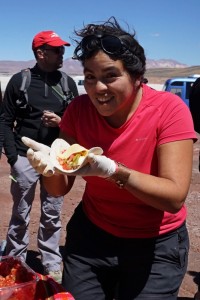Caldera & San Pedro de Atacama: March 14 – 18, 2017
Day 9 Tuesday: Drive 350km from Laguna Verde to Caldera
Around 7am, I heard a man telling his friend to come out to watch the moon and sunrise. As I could not sleep anyway, I fetched my camera and climbed to the top of the cliff behind our tents. I got there just in time to take a couple of pictures with the moon over the snow-clad mountain at one end of the lake and the sun rising at the other end. What a beautiful moment!
We did not have breakfast till 10am. As the party had reached the summit one day before schedule, we had gained an extra day. After some discussions, we decided to return to Caldera and ask Maximiliano to take us to the Pan d’ Azúcar National Park the following day. Here visitors can find the Humboldt penguins. While I packed and got ready in 15 minutes, Mario, Hernán and Fabiola had to spend two hours to pack and take down the communal tent. We finally set off at 1:20pm and had a scenic drive on the desert road with a brief stop at Copiapó for shopping.
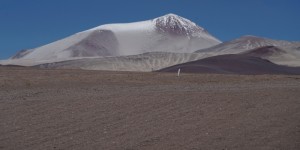 |
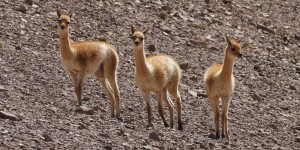 |
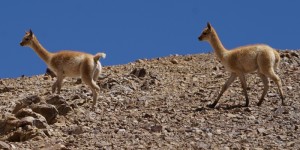 |
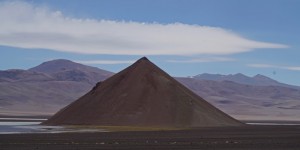 |
We finally arrived in Caldera before 7pm and were met by Maximiliano who arranged us to stay at Apart Hotel Caldera. We took two en-suite rooms, each with a double bed and two bunk beds (2,500 CLP a night for a room). Monica stayed with me.I went immediately to the bus company to buy a ticket to San Pedro de Atacama on March 16. My friends were busy arranging food for a drink party in the terrace. We had cheese, sausage, ham, beer, red and white wine while watching sunset. About 10pm, I collapsed into my bed and slept before Monica came out of the shower.
Day 10 Wednesday: Excursion to Pan d’ Azúcar National Park
I had Wi-Fi for the first time since March 6 and spent almost two hours in catching up with emails and messages. My Chilean friends turned up after 9:30am and Maximiliano helped me to change money in the bank. This time, I got 660 CLP for a dollar and paid no commission. This shows how bad the deal is at the Santiago airport.
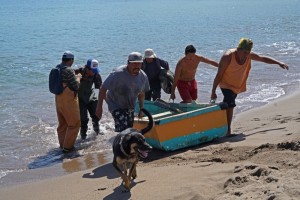 |
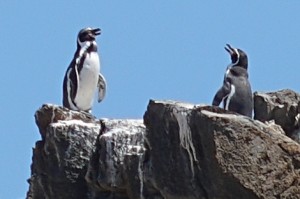 |
After 10am, we were on our way to the “Sugar Loaf National Park” in English. Part of the coastline is dramatic showing extensive volcanic activities with lava flowing into the sea. We stopped at the Caleta Pan d’ Azúcar, a small fishing village which is now a popular beach and departure point for penguin viewing. Mario arranged a boat trip to the Isla Pan d’ Azúcar (the sugar loaf island) where the penguins breed. It cost 10,000 CLP per person. I invited Fabiola to go as my guest.
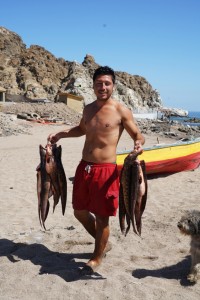 |
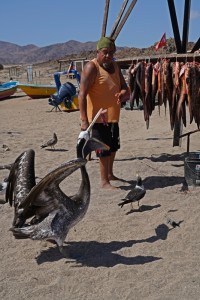 |
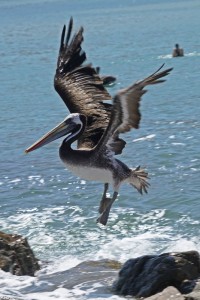 |
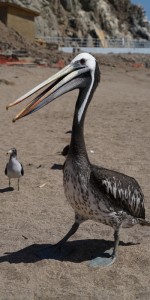 |
While waiting, we watched fishermen coming back with their daily catch most of which was eel. I spotted three white fish which the locals use for cerviche (minced raw fish in lemon juice). I brought all three for 7,000 CLP and Hernán showed us how to prepare this famous South American dish: he cut the fillet in small cubes, squeezed half a dozen of fresh lemons on the raw fish and added lots of chopped union. He mixed them all together before wrapping up the container with a plastic bag. The fish was marinated for the next two hours.
We boarded a boat with half a dozen local tourists and spent an hour and a half at sea. We were lucky to spot six penguins which nearest relatives are the African, Magellanic and the Galapagos penguins. Two were standing at the top of the rocky island which is about 50-70m above sea level. They must be strong climbers! We also saw plenty of birds and sea lions. The weather was fine and the sea was calm. A fantastic day!
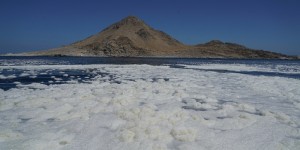 |
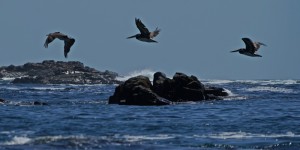 |
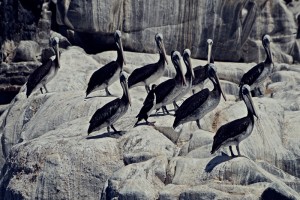 |
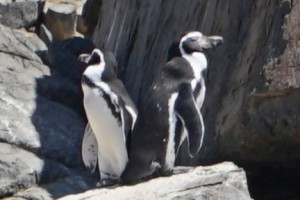 |
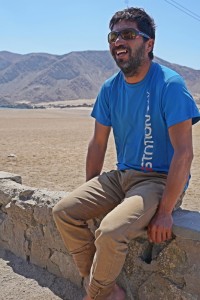 |
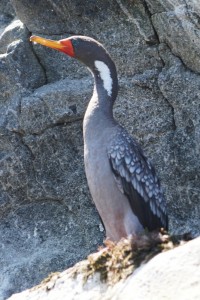 |
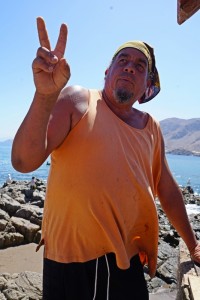 |
When we got back to the beach, I saw another boat coming in with two large bags of fresh abalones. I loved to buy some but the fishermen moved on before I could bargain with them. What a pity! But I had a consolation prize: the fisherman gave me something like a barnacle (but big and round like an abalone) to try. It’s raw and most delicious: the texture is tender yet chewy. They call it a ‘sweet’ of the sea! What is it exactly? I really want to find out the name and look for it next time! We had a perfect lunch at the beach. First, we had cerviche as starter followed by steak as the main course. We had wine and beers. What a fantastic way to end our expedition!
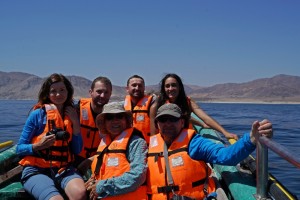 |
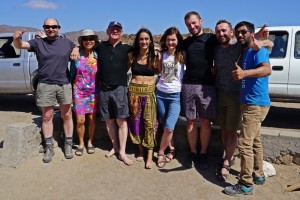 |
At 6pm we were back in our hotel. Time to say good-bye to our Chilean friends who drove off to Santiago! My Polish friends were busy shopping and preparing another sunset drinking party. We had a great evening finishing three bottles of wine. I asked them to send the photos they had taken at the summit and with their Ambassador. END OF EXPEDITION TRIP
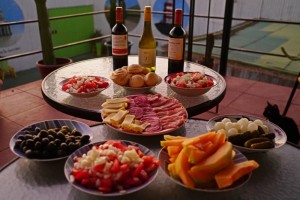 |
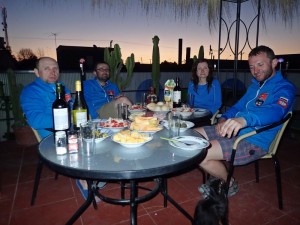 |
March 16 Thursday: Travel Day Caldera to San Pedro de Atacama (over 800km)
I paid 1,840 CLP for the ticket to San Pedro de Atacama (the full fare was 31,300 CLP). My friends walked me to the bus terminal. They are very sweet and have given me many ideas on hiking in Poland. I do hope we would meet again one day. The bus was late by 10 minutes and I said good-bye to my friends around 11:30am.
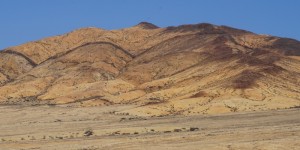 It’s the first time I took a long distance bus in Chile. The bus looked good but the public address system was faulty making noises all the way. It drove me crazy. As a result, I lost interest in the scenery which anyway looks dull. The bus made several stops along the way including a 30-minute break in Antofogasta. It arrived in Calama at 10pm when all passengers had to get off. I waited another half an hour for a connecting bus. I was relieved when the bus to San Pedro finally pulled out of the terminal. After five minutes, it suddenly stopped by the roadside for half an hour. What had happened? No one knew.
It’s the first time I took a long distance bus in Chile. The bus looked good but the public address system was faulty making noises all the way. It drove me crazy. As a result, I lost interest in the scenery which anyway looks dull. The bus made several stops along the way including a 30-minute break in Antofogasta. It arrived in Calama at 10pm when all passengers had to get off. I waited another half an hour for a connecting bus. I was relieved when the bus to San Pedro finally pulled out of the terminal. After five minutes, it suddenly stopped by the roadside for half an hour. What had happened? No one knew.
My nightmare began. It was almost 1am when I got off the bus in San Pedro. This must be one of the worst bus rides I ever had. I met two young girls from Canada on the bus. As it was late, I decided to look for accommodation with them. A man from Hostal Nuevo Amanecer met arriving passengers and offered a dormitory bed for 10,000 CLP. But my friends had their mind set on another hostel. I should have trusted my instinct and gone with the man from the hostal.
Anyway, they relied on their GPS and took a roundabout way to the hostel. As it had rained heavily earlier in the day, the path was muddy. My suitcase was heavy and I struggled and had to stop in the middle of the path to catch my breath on a couple of occasions.
They finally found Hostel Tatis and sat down to bargain for another half an hour. They finally got a bed for 8,700 CLP. This hostel looks cozy but fairly dirty. The rooms are small with 4 to 8 beds. When the receptionist showed me the room with the last bed, I could not stand the mess and the smell. I finally took a private room without facility for 20,000 CLP. There is no lock on the door and the window cannot be closed! It has Wi- Fi though. So I was online till 3am. After a few hours’ sleep, the receptionist knocked on my door and told me to move to a bunk-bed as the room would be taken by a couple in an hour’s time. It’s the poorest place I have stayed in recent years.
March 17 Friday: San Pedro de Atacama
San Pedro de Atacama, a town and commune in El Loa Province of the Antofagasta Region, has grown around an oasis at an elevation of 2407m in the Puna de Atacama, an arid high plateau. Its first inhabitants were the Atacameños. The area was part of Bolivia since independence till Chile claimed ownership during the War of the Pacific. It has grown into a major tourist centre since my first visit in 1999. Given its history, spectacular landscape and extraordinary scenery, it has been popular with backpackers, cultural tourists as well as nature-seekers.
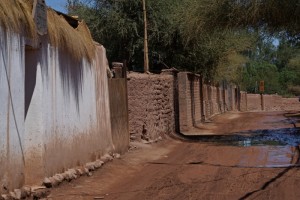 |
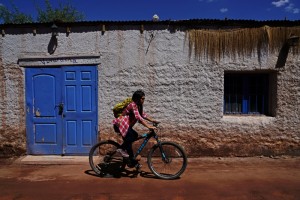 |
I have fond memories of San Pedro where I spent three days in 1999 with Shelley (my niece from Australia), Kai (my university friend from Hong Kong) and Michel (a friend from Belgium). We visited the Valley of the Moon, El Tatio to see a geyser field with over 80 active geysers and Laguna Verde and Laguna Blanc in Bolivia. During this visit, I find the town has grown a lot though it manages to retain some of its old rustic charm. It must have the highest concentration of tour agencies in the country. There are dozens of trips for trekking, climbing, archaeological sightings, amateur astronomy, adventure tourism and overland trips to Bolivia.
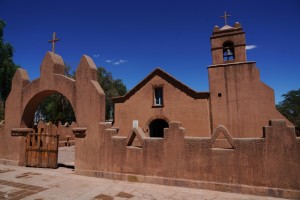 |
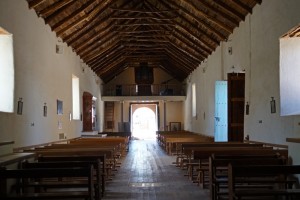 |
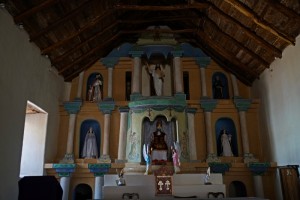 |
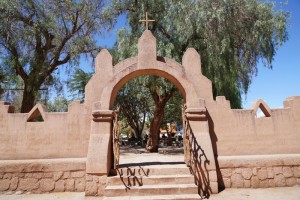 |
I had a busy day. First, I bought a bus ticket to Salta, Argentina on March 19. It’s on promotion: I paid 22,000 CLP. Second, I had to look for a better place. I found my way back to Hostal Nuevo Amanecer which is a few minutes’ walk from the terminal. The hostal is in a nice new neighbourhood and the rooms are decent and clean. The common room with kitchen is large and comfortable. Even the dormitory with five beds (not bunk beds) looks airy, bright and clean with its own toilet and shower. I took a nice room for 25,000 CLP a night. Had I followed the man at the terminal, I would have saved myself all the troubles! In the hostal, I met a young Korean couple who told me about the two trips they had joined i.e. a half day trip to the Valley of the Moon and a star gazing trip. Third, I walked to the town centre and booked three trips from the same company for US$98 (two trips on March 17 and a full day excursion on March 18).
As the trip to the Valley of the Moon would start at 4pm, I spent the afternoon having lunch. I was hungry as I had nothing the day before. Then I strolled around this idyllic oasis town which has managed to keeps a rustic desert feel: there is no paved road in the old town though most of the dwellings have been turned into shops, tour offices, eateries, hostals or hotels.
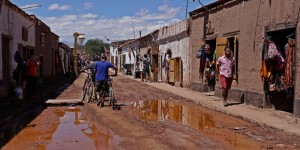 As it had rained heavily the day before, the path was muddy with pools of water everywhere. A different feel! I visited the iconic church, reportedly the second oldest church in Chile. Built with indigenous adobe material, the church which patron saint is Peter, is simple, rustic and charming. As I was running out of time and did not visit the R.P. Gustavo Le Paige Archaeological Museum which has a large collection of relics and artifacts from the region.
As it had rained heavily the day before, the path was muddy with pools of water everywhere. A different feel! I visited the iconic church, reportedly the second oldest church in Chile. Built with indigenous adobe material, the church which patron saint is Peter, is simple, rustic and charming. As I was running out of time and did not visit the R.P. Gustavo Le Paige Archaeological Museum which has a large collection of relics and artifacts from the region.
At 4pm, I joined a small group to the Valley of the Moon, a moon-like landscape with ruins of old Chilean salt mines, and worker huts. The guide is a young lady with a sweet smile. But she is not well-organised and does not give much information. We first went to the Great Dune where we had to walk to the top for panoramic views. She gave me half an hour to walk around. Both I and the Korean couple followed her instruction while the rest of the group did not turn up 35 minutes later. It’s totally unacceptable as I could have walked the full length of the dune with an extra 30 minutes. The guide knew I was angry and kept apologizing.
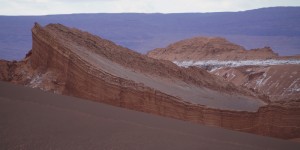 |
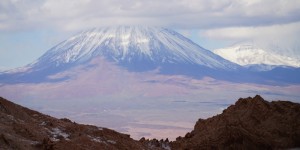 |
We then had a brief photo stop at the ‘Three Marias”- a sculpture and art work of nature.
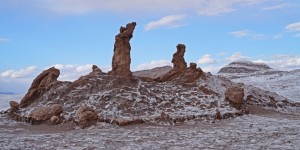 |
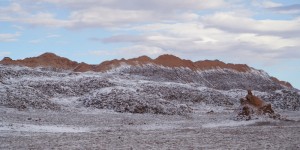 |
The third stop was at a natural salt cave which I find most interesting. The salt looks like crystal and we had to crawl through narrow gaps and tunnels. We had to climb up steep slopes too.
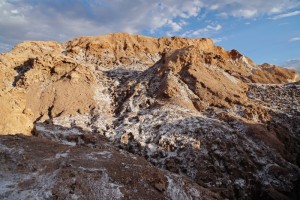 |
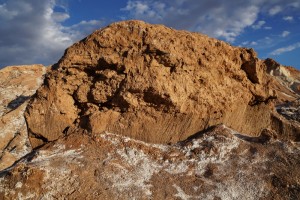 |
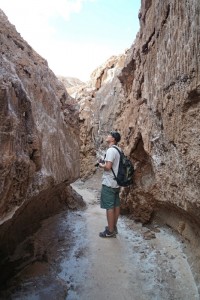 |
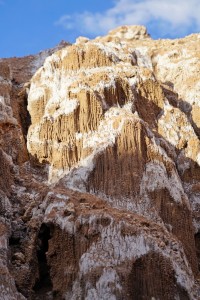 |
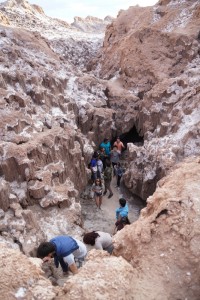 |
The last stop was at a sunset viewing point. The guide pointed out some of the notable volcanoes including Licancabur and Llullaillaco (6723m), the second highest volcano in the world which is sacred to the indigenous people. I had joined a tour to the Valley of the Moon in 1999. But I have not been taken to any of these spots! I therefore had an enjoyable trip.
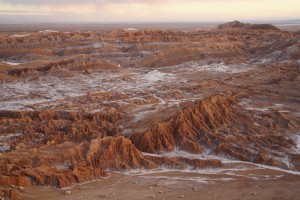 |
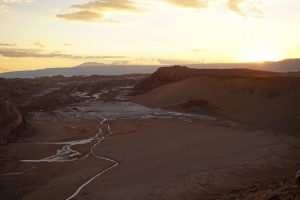 |
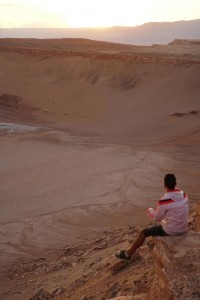 The Astronomic Tour (the Path of Stars) did not begin till almost midnight. A driver took the Korean couple, a mother and son from Buenos Aires and I to somewhere without light pollution outside the town. A Chilean guy who speaks English twas our guide while the mom and son had a Spanish-speaking guide. Our guide tried to point out a few constellations to us. But my Korean friends were too busy taking photos to listen. So I had a personal guide for the night. He showed me a few constellations through the telescope and I saw the Orion, Southern Cross, the Milky Way and a number of prominent stars. The moon was bright and I had a close look at its surface. I also looked at the Jupiter and its moons. Unfortunately, I was too tired to fully enjoy the trip. It was after 1:30am when I collapsed onto my bed.
The Astronomic Tour (the Path of Stars) did not begin till almost midnight. A driver took the Korean couple, a mother and son from Buenos Aires and I to somewhere without light pollution outside the town. A Chilean guy who speaks English twas our guide while the mom and son had a Spanish-speaking guide. Our guide tried to point out a few constellations to us. But my Korean friends were too busy taking photos to listen. So I had a personal guide for the night. He showed me a few constellations through the telescope and I saw the Orion, Southern Cross, the Milky Way and a number of prominent stars. The moon was bright and I had a close look at its surface. I also looked at the Jupiter and its moons. Unfortunately, I was too tired to fully enjoy the trip. It was after 1:30am when I collapsed onto my bed.
March 18 Full Day Excursion (over 200km)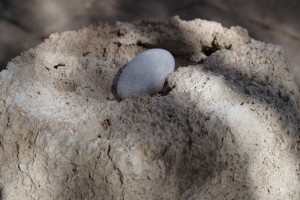
I had less than six hours’ sleep as I was told to wait for a pick-up at 7am. It turned out that I was the last passenger to be picked up: it was after 7:30am when I boarded the minibus which was full. The guide gave a lot of information about the places, the people and customs. Unfortunately, she spoke without microphone and her voice was low and soft. I could not hear at the back. We had a long day with several stops.
Laguna de Chaxa, the eastern sector of Atacama Salt Lake (2300m above sea level) and 62 km south from San Pedro. The salt lake, part of the National Reserve for Flamingos, has strung considerably in recent years. Three types of flamingos namely Andean, Chilean and James flamingos are found here. We spent over an hour here and had a breakfast by the minibus after a walk for half an hour. The guide said the number of flamingos here dropped this year as a result of a disastrous heavy rainfall that destroyed the nests the year before. Hence many flamingos have not returned to lay their eggs this year.
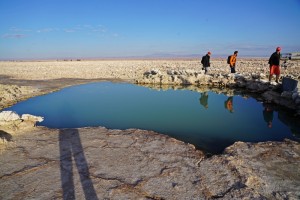 |
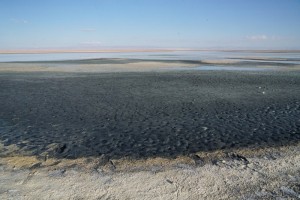 |
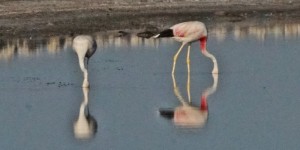 |
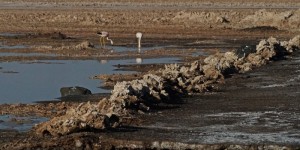 |
Socaire, a very small community with about 100 inhabitants. The old church and the bell tower are the main attractions.
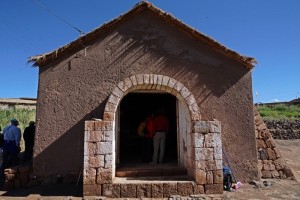 |
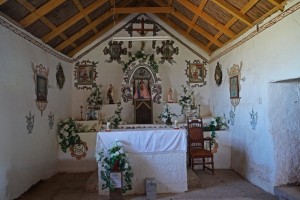 |
A scenic drive to two Altiplano lagoons (about 110 kms south of San Pedro). Both are part of the National Reserve of Flamingos. Miscanti Lagoon has a surface area of 15km² with Miscanti Peak (5622m) providing a magnificent backdrop. As it had snowed recently, there was a thin sheet of ice in the middle of the lake. A rare sight!
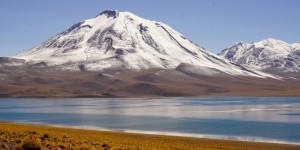 |
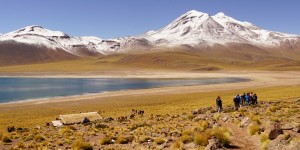 |
Visitors are not allowed to get close to the lake: they can only walk along a trail. The guide told us to follow her but I stayed at the back for a couple of photos. Then I lost sight of the group. As I thought the group was walking ahead, I walked fast in order to catch up with them. By the time I got close to the group where the vehicles were parked, I realised it was not my group. Our driver said the group was still far behind. I wished the guide had simply indicated the path to take and the time to be back to the bus. It’s impossible to follow a group as there were half a dozen groups descending on the lake at that time. Anyway, I prefer to walk and explore at my own pace.
Though I am time rich, I hate wasting time. I told the driver that I would continue with the walk to the end of the lake and re-board the bus there. He fully understood. But my group members were shouting at me calling me to return to the bus. I ignored them and walked on. After this incident, the guide knew my temperament and preference: she would let me know the time to be back to the vehicle and leave me alone.
Miñiques Lagoon (at an elevation of 5910m) adjacent to the Miscanti Lagoon only has a surface area of 1.5km². It is an important breeding ground of an endangered bird, wari or tagua cornuda (horned coot?). I saw many vicuñas roaming in the area.
Lunch break at the Piedra Roja (Red Stone) by a lake. Here we had time to walk on our own before and after a light lunch.
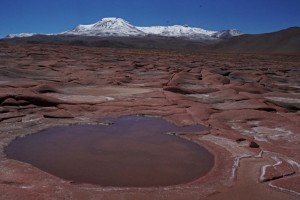 |
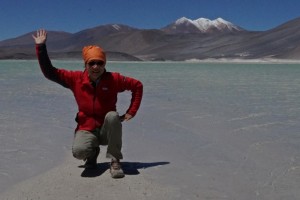 |
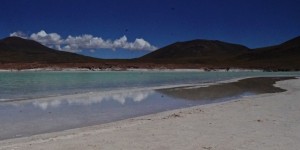 |
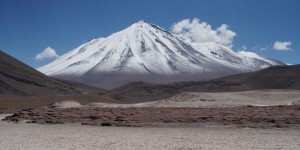 |
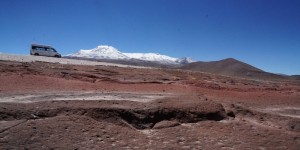 |
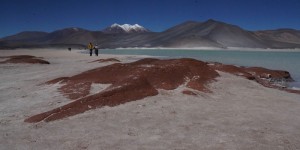 |
Around 3pm, we headed back to San Pedro along Route 23. We stopped at Toconao (2485m above sea level) which had a wine festival that day. The town has been built entirely by Liparita stone of volcanic origin. The bell tower was built in 1750. We spent almost an hour in this small town looking at an old church and three markets set up for the festival. I tried the local wine which is too sweet to my liking. I bought some figs which are tasty and sweet.
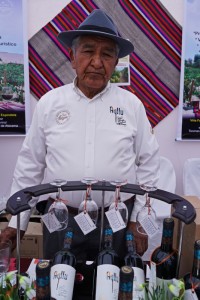 |
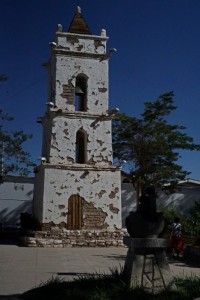 |
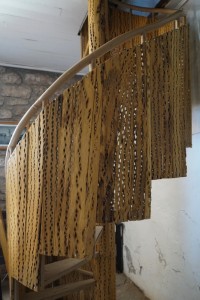 |
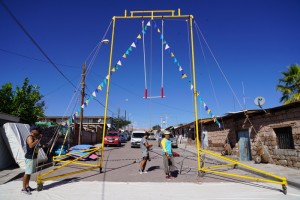 |
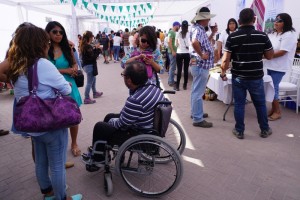 |
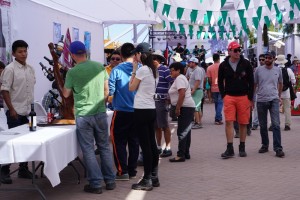 |
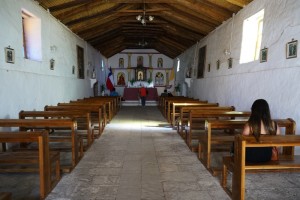 |
It was after 6pm when I was back in my hostal. The guide had suggested me try Cazuela de Vacuno, a soup with pieces of meat, potato, corn, carrots, unions, green beans, garlic etc in a local eatery near the stadium. I followed her advice and had a most wholesome and delicious meal for only 2,000 CLP. I walked around the central square and the church for the last time.
Remarks
I made this trip to Chile primarily for the expedition to Ojos del Salado. I returned to San Pedro de Atacama because I like it. Also it is a springboard to Northern Argentina. Things have worked out beautifully. First I know my physical limit and am glad to be able to hike beyond 6000m as long as I do not need to wear heavy boots and crampons. This time, I only walked for three days from about 3700m to over 6000m. As a result, I had a leisure hike which was not exhausting or demanding. Second, I was fortunate to have two most competent guides, Mario and Hernán and meet four young friends from Poland. I hope to meet them again in Hong Kong or Poland. Third, San Pedro de Atacama has not disappointed me even on my second visit. Its tourism industry is now very mature as the region is full of natural wonders. Despite its touristy feel, I still like it and do not mind to return for the third time to go north to Bolivia. Finally, after travelling over 1500km in the Atacama Desert and Puna de Atacama in Chile, I come to the conclusion that the landscape and scenery around San Pedro de Atacama and Ojos del Salado are ‘must-see’ in northern Chile. Worth the journey!
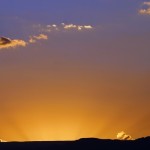 |
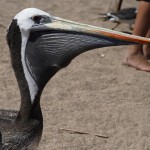 |
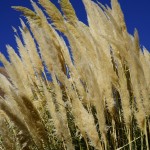 |
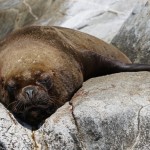 |








